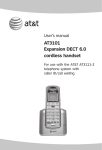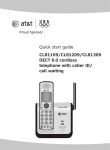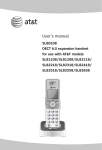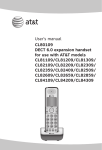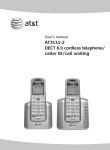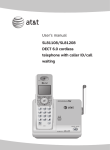Download E-Z-GO Terrain 250 - Electric Specifications
Transcript
STQ EZ9 2001 PERFORMANCE ENHANCEMENT KIT For EZGO NON-DCS Installation Instructions We would like to thank you for purchasing our exclusive Motor & Controller Performance Enhancement Kit. We take great pride in our products and feel certain that this kit will offer you many years of troublefree service. We ask that you take a moment to read these instructions completely before beginning your installation. Familiarity with the parts and an understanding of the procedures will ensure that your installation goes smoothly and safely. Additionally, it will give you an opportunity to determine if your cart might have any damaged, corroded, or missing parts, which will need replacing prior to using your new Performance Enhancement Kit. ABOUT THIS PERFORMANCE ENHANCEMENT KIT This Performance Enhancement Kit is designed specifically for 1994.5-Present EZGO Non-DCS 36 and 48 volt electric golf carts. If you are unsure of your golf cart type, please see our catalog or contact our technical department, toll free at 1-888-444-9994, or online at www.buggiesunlimited.com. During the installation of this kit you will be upgrading three major electrical components from your golf cart, with three high performance components in our STQ EZ9 2001 Performance Enhancement Kit. These parts are: the motor, the speed controller, and the solenoid. All of your electrical connections will be made between these components and either the battery group or a device called a forward/reverse switch. You should allow about 4 hours for installation. PARTS INCLUDED IN OUR KIT 1) 2) 3) 4) Electric motor (per application). 500 amp speed controller 36/48 volt. Electric solenoid (36/48 V high performance). 4 Gauge Cable Kit (Non-DCS), including: a) 3 red coded cables. b) 1 blue coded cable. c) 1 white coded cable. d) 1 orange coded cable. e) 1 green coded cable. f) 1 black coded cable. g) 5 red/black coded cables. 5) Bridge Resistor (250 ohm) and diode. 6) Hardware kit. 7) 2 Contacts, F&R Switch C 1 Contacts TOOLS AND MATERIALS REQUIRED TO INSTALL KIT 1) SAE socket set, with ratchet and 3” and 6” extensions. 2) 8mm deep socket 3) SAE combination wrench set. 4) 1/2” wrench (extra). 5) #2 Phillips and Flat Tip screwdrivers. 6) Wire cutters. 7) T15 Torx driver. 8) Heavy weight grease. 9) Wire Terminal Crimper 10) Safety Goggles/Glasses ADDITIONAL TOOLS WHICH MAKE THE JOB BETTER AND FASTER 1) 2) 3) 4) 5) Battery Carrying Strap. Part # BT8001. Battery Terminal Protector Spray. Part # BT60512. Battery Terminal Re-facer. Part # BU6002. Electronic Multi-meter. Part # BU6001. Small Box of Baking Soda. Local store purchase. BT8001 BT60512 BU6002 BU6001 A NOTE BEFORE STARTING Throughout this installation, we will be discussing the connection of #4 heavy gauge cables to several different electrical components. Some cables will be attached to THREADED LUGS or “posts”, and others will be attached to FLAT Buss BARS. An understanding of each of these cable connections is important. Let’s first cover the THREADED LUGS. You will notice these lugs utilize a set of double nuts to hold the cable terminal firmly in place. Typically, a cable terminal and a washer will be sandwiched between these two nuts. This configuration is deliberate, and care should be given to properly removing or installing these nuts. An open-end wrench of the appropriate size should be held on the bottom nut while another wrench or socket is used on the top nut to either loosen or tighten this connection. The use of opposing wrenches relieves the threaded lug of excessive stress and eliminates the possibility of damaging the seals at the base of these lugs. Failure to use the opposing wrench technique on double-nutted lugs can permanently damage the component. You will also want to use the opposing wrench technique when making connections at the FLAT Buss BARS, but care should also be given to avoid twisting or bending the bars. Again, these seals at the base of the connection points are fragile and subject to damage if handled improperly. Seal damage at these electrical contact points will void the warranty for that component. 2 INSTALLATION 1) SEAT CUSHION REMOVAL: Remove the seat assembly by lifting the side grab handles. The cushion hinges to the front of the cart, and will simply lift off when it’s in the vertical position. 2) ACCESS PANEL REMOVAL: Remove the black plastic rear access panel located behind the seat, which is secured using five T15 Torx head screws. 1 3) BATTERY REMOVAL: There are two things to take note of here: Battery placement and wiring layout. NOTE: Battery acid can be very damaging... wear rubber gloves, eye protection, and old clothes. Work in a well-ventilated and appropriate area for the task. Battery residue can stain concrete. Observe the position and orientation of the battery group, as you will want to reinstall all the batteries in the same manner. Failure to orient the batteries correctly can leave some wires too short or too long for their intended purpose. Hint: As you remove and set the batteries aside, place them in a grouping just as they appeared in the battery tray of your cart. This will leave no doubt as to their original position. Also take note of your battery cables. You’ll see that 2 the batteries are always connected to each other in a series configuration… that is “positive” to “negative” to “positive” to “negative” and so on through all six batteries. Confirm that your battery cables appear like those in the wiring diagram, and remove all existing wiring from the batteries. There will be other smaller wires connected to some of the batteries on your cart. Write down the location of those smaller wires, as you will be reinstalling them in those same locations after you have completed the installation of the Performance Enhancement kit. Hint: Labeling the wires with a small piece of masking tape will go a long way in avoiding confusion upon reinstallation. Once you have made the above notations and removed the cables and wires, you can release the batteries by using a 1/2” or 9/16” socket to remove the two nuts and washers on the bolts of the hold-down plate centered in the battery grouping. Note: Use care in lifting the batteries from the cart…they are very heavy. A battery carrying strap makes this job much easier. 3 3 l ne Pa ss ce Ac 4 3 5 2 6 1 4) SPEED CONTROLLER AND SOLENOID REMOVAL: Directly below the passenger’s seat you will find a black plastic cover… this is called the controller cover. The cover is secured using four hex head machine bolts. Remove these bolts using a 3/8” socket with the appropriate extension. Underneath the cover you will notice the speed controller and the solenoid. The speed controller is the small metal box and the solenoid is the cylindrical device mounted on top of the controller. Begin the removal of these components by first discharging the speed controller. Using a standard screwdriver bridge the terminals marked “B-” and “B+”. You may see or hear a small spark and this is normal, and is an indicator that the capacitors inside the speed controller have been discharged. Let’s begin with the SOLENOID (the cylindrical device). You will notice it has two large lugs and two smaller lugs. You will be replacing all the cables on the large lugs with cables from our new Performance Enhancement Kit, but the wires attached to each of the smaller lugs will be kept and reattached to the new solenoid. Don’t forget to use the opposing wrench technique when removing these wires and cables. Moving on to the SPEED CONTROLLER. You will notice it has three large flat buss bars and one 6-pin Molex connector. The Molex connector may have a small tab which needs to be depressed in order to pull the connector from the speed controller (4c). Do not pull the Molex connector by the wires… grip the body of the connector and wiggle it back and forth as you pull outward. Just like on the solenoid, you will be replacing the large cables on the speed controller with new cables from our STQ EZ9 2001 Performance Enhancement Kit, but the smaller wires in the 6-pin Molex connector will be retained and reinstalled on the new speed controller. Remember to use the opposing wrench technique, and to avoid twisting or bending of the buss bars. Once all of the wires and cables have been disconnected, release the mounting hardware of the controller and the solenoid and remove those components from the cart. Retain the 3 metric bolts, which hold the controller, as they will be used later. Controller Cover 4a. Controller Cover (On) Solenoid Molex Connector Contr oller 4c. 6-Pin Molex Connector Removal 4 4b. Controller Cover (Off) 5) FORWARD/REVERSE SWITCH WIRE REMOVAL: Locate the forward/reverse switch assembly, which is found directly in front of the speed controller mounting area. Remove all four heavy gauge cables from the switch assembly and retain the factory hardware for reinstallation of your new cables. See the wiring diagram (pg. 12) for a visual representation of the forward/reverse switch assembly. 6) FINAL CABLE REMOVAL: You will find four (4) large threaded electrical lugs on the case of the motor, with one cable connected to each lug. Remove these cables, remembering to use the opposing wrench technique. Once you have removed the cables from the motor, all of the heavy gauge cables in your cart should now be disconnected from their mounting points, and you may remove them from the cart, while taking note of the paths in which they were routed. 7) MOTOR REMOVAL: Before removing the motor, clean the surrounding area of any excessive mud or dirt, which may have accumulated on nearby parts. We want to ensure that internal parts stay as clean as possible. Once the area is clean, you will notice three hex head bolts on the differential case, which bolt through to the motor. Using a 7/16” socket, remove these bolts to release the motor from the housing. If your cart has a cable-retaining loop fastened to one of the motor mount bolts, release that bolt first, and then remove the remaining two bolts. Carefully pull the motor from the housing. Some gentle back and forth pressure, while pulling the motor, should allow the motor to slide off the shaft. Use caution, as the motor is heavy and will drop quickly once it is free from the shaft. 5. Forward & Reverse Assembly Mot or 6. Opposing Wrench Technique Di f Ca fere nt se i al 7. Gentle Back and Forth Pressure To Remove Motor 5 8) COMPONENT INSTALLATION PREPARATION: Before installing our Performance Enhancement Kit in your cart, take a little time to clean the areas now exposed by the removed components. The motor mount may have some grit or dirt around the opening of the mount. A moist rag or small brush can be used to clean that area. Avoid letting dirt fall into the housing. The battery trays may have dirt, leaves, or corrosion, which should be cleaned. For instruction on cleaning corrosion, see step 12. While the mounting surface of the controller should be quite clean, inspect it and wipe it down with a damp cloth to remove dirt or film. This area acts as a heat sink and dirt will interfere with its performance. 9) MOTOR INSTALLATION: Before mounting the motor, lubricate the splines, but not the end of the motor shaft with quality heavy-weight grease… available at any auto parts store. Lifting the new motor up, slide it onto the shaft inside the motor mount housing. With some gentle back and forth movement and pressure toward the housing, the motor should mount up to the housing with little effort. Align the mounting holes of the housing and the mounting holes of the motor by rotating the motor slightly. When aligned properly, the threaded electrical lugs of the new motor will be on bottom and the mounting bolts can be inserted. Don’t forget to reinstall your cable-retaining loop, if your cart has one. Observe a rotating or crisscross pattern as you tighten the mounting bolts, to ensure that the motor is not binding or stressed. Tighten securely… but avoid over tightening. 10) CONTROLLER AND SOLENOID INSTALLATION: In the kit you will find a new solenoid that mounts on back of the controller. Install the diode across the two small terminals. Install the resistor across the two large terminals. Install the fuse on the number one battery positive teminal. After all cables are installed connect the main soleniod positive cable to the open end of the fuse Figure 10. 11) CONNECTING THE CABLES: It is now time to connect the cables to your new controller, solenoid, and motor. a) Locate the small resistor wire from the hardware pack. It is a short wire with a ring terminal on 6 8. Clean the Motor Mount Area 9. Motor Installed 10. b) c) d) e) f) each end. This wire will jumper across the two large threaded lugs of the solenoid. Recall that the solenoid is one of the components which will have the double nuts installed on the lugs. Ensure that the bottom nut is threaded onto each of the two large lugs, and then install the wire by placing one ring terminal over each large threaded lug. It may be necessary to bend the wire slightly to make it fit… this is normal. Locate the red coded cable that is 27” long. Place one end of this cable onto the large threaded lug of the solenoid, which will be closest to the batteries (or the driver’s side of the cart). Using 1/2” wrenches, tighten the connection securely using the lock washer and top nut provided. Remember to use the opposing wrench technique. The other end of this cable will be connected to the positive terminal of battery #1 after the batteries have been installed. Locate the red coded cable that is 8” long and connect one end of this cable to the electric buss bar marked “B+” on the controller. Tighten the provided nut and bolt securely using 1/2” wrenches. Remember to use the opposing wrench technique and avoid twisting or bending the buss bar. The other end of this cable will be connected in step 11e. Locate the red coded cable that is 54” long and connect one end of this cable to the threaded lug marked “A1” on the motor. Recall that the motor is one of the components that will have double nuts installed on the lugs. Ensure that the bottom nuts are threaded on each of the four (4) lugs of the motor. Using 1/2” wrenches, install the cable and tighten securely using the opposing wrench technique. The other end of this cable will be connected in step 11e. Locate the unconnected ends of the red 8” cable and the red 54” cable, and place them together on the other large threaded lug of the solenoid. Using 1/2” wrenches, tighten the connection securely using the lock washer and top nut provided. Remember to use the opposing wrench technique. Locate the blue coded cable that is 47” long and connect one end of this cable to the threaded lug marked “A2” on the motor. Using 1/2” wrenches, install the top nut and tighten securely using the opposing wrench technique. Using a 1/2” wrench and the factory hardware, connect the other end of this cable to position “C” of the forward/reverse switch assembly, as shown on the wiring diagram (pg. 12). Tighten securely, but use caution to avoid over tightening. 7 Resistor 11a. Resistor Installation 11b,c & e. Red Cable Installation on Solenoid and Controller 11d,f,h & i. Motor Cable Installation C B D A 11f,g & h. Blue, Green & Orange Cable Installation on Forward/Reverse Switch g) Locate the green coded cable that is 27” long and connect one end of this cable to the electric buss bar marked “M-” on the controller. Tighten the provided nut and bolt securely using 1/2” wrenches. Remember to use the opposing wrench technique and avoid twisting or bending the buss bar. Using a 1/2” wrench and the factory hardware, connect the other end of this cable to position “A” of the forward/reverse switch assembly, as shown on the wiring diagram (pg. 12). Tighten securely, but use caution to avoid over tightening. h) Locate the orange coded cable that is 45” long and connect one end of the cable to the threaded lug marked “S1” on the motor. Using 1/2” wrenches, install the top nut and tighten securely, remembering to use the opposing wrench technique. Using a 1/2” wrench and the factory hardware, connect the other end of this cable to position “D” of the forward/reverse switch assembly, as shown in the wiring diagram (pg. 12). Tighten securely, but use caution to avoid over tightening. i) Locate the white coded cable that is 41” long and connect one end of this cable to the threaded lug marked “S2” on the motor. Using 1/2” wrenches, install the top nut and tighten securely, remembering to use the opposing wrench technique. Using a 1/2” wrench and the factory hardware, connect the other end of this cable to position “B” of the forward/reverse switch assembly, as shown in the wiring diagram (pg. 12). Tighten securely, but use caution to avoid over tightening. j) Locate the black coded cable that is 36” long and connect one end of this cable to the electric buss bar marked “B-” on the controller, as shown in the wiring diagram (pg. 7). Tighten the provided nut and bolt securely using 1/2” wrenches. Remember to use the opposing wrench technique and avoid twisting or bending the buss bar. The other end of this cable will be connected to the negative terminal of battery #6 after the batteries have been installed. 12) BATTERY INSTALLATION: Before installing the batteries, there are a few steps you should take to ensure optimal performance from your new STQ EZ9 2001 Performance Enhancement Kit. Begin by giving your batteries a thorough cleaning. Dirt can be removed with a scrub brush 8 11g & j. Green and Black Cable Installation on Controller C D B A 11i. White Cable Installation on Forward/Reverse Switch 11. Cable Installation on Solenoid, Controller and Forward/Reverse Switch and warm soapy water. Residual corrosion and acid spillover can be removed with a baking soda and water mixture using one small box of soda to one gallon of water. Remember, Battery Strap battery acid can be very damaging… wear rubber gloves, eye protection, and old clothes. Work in a well-ventilated and appropriate area for the task. Battery residue can stain concrete. Next, re-face the contact surfaces of your battery terminals, as this will ensure good electrical contact with the new cables of your Performance Enhancement kit. While this can be done with a wire brush, the best tool for this task is our battery terminal re-facer, which insures a flat, smooth surface and maximum electrical contact between the terminal and the battery. Also, inspect the battery-water level in each cell of each battery and fill to the proper level. While the caps are off, wipe them with a moist rag and inspect them for cracks, clogged ventilation holes, or other damage. Lastly, check the condition of the battery hold-down bolts. If they are damaged, or corroded, replace them now. Once these steps are completed, you may install the batteries into the battery tray, remembering the importance of arranging the batteries just as they were when you removed them. Generally, it is easier to 12. Battery Installation first install the three batteries to the rear of the cart, followed by the three batteries in the front. The battery hold-down bolts create a bit of a balancing act, but with a little patience and persistence you will have all six batteries installed, and you will be able to set the hold-down plate over the bolts and secure them using the factory hardware and a 1/2” or 9/16” wrench. 13) BATTERY WIRING: A note on battery wiring: With new cables and re-faced battery posts, you are prepared to make an excellent connection at each battery post. The last factor in a great connection is a good tight fit of the terminal to the post. You will want to tighten all of your lug nuts securely (90-110 inch lbs.), but avoid over tightening. Putting too much effort into securing the nuts can distort the battery plates and care should be given to supporting the post while tightening. Stripped threads will lead to loose connections, increased heat, and premature failure. Battery lug nuts typically require 1/2” or 9/16” sockets… use whatever size socket fits your particular application. a) Locate the four (4) cables, which are 7” long. Using the Heavy Gauge Wiring Diagram for reference (pg. 12), install one cable between the negative terminal of battery #1 and the positive terminal of battery #2. Install another 7” cable between the negative terminal of battery #2 and the positive terminal of battery #3. Install another 7” cable between the negative terminal of battery #4 and the positive terminal of battery #5. Install the last 7” cable between the negative terminal of battery #5 and the positive terminal of battery #6. Tighten securely using the above-mentioned cautions. b) Locate the cable, which is 11” long. Using the wiring diagram for reference, install this cable between the negative terminal of battery #3 and the positive terminal of battery #4. c) Before proceeding, insure that the key is removed from the ignition switch. d) Locate the 21” long red coded cable, which you installed in step 11b. Connect the free end of this cable to the positive terminal on battery #1. It is critical that this connection is made accurately! This wire should run only from the battery side (or passenger side) large threaded lug of the solenoid directly to the positive terminal of battery #1. Double-check your work before proceeding. e) Locate the 29” long black coded cable, which you installed in step 11j. Connect the free end of this cable to the negative terminal on battery #6. It is critical that this connection is made accurately! This wire should run only from the “B-” buss bar of the speed controller to the negative terminal of battery #6. Double-check your work before proceeding. 9 f) g) Connect the six pin Molex connector to the corresponding controller five pins. Make sure of proper alignment while pushing the connector on. Tech Tip: notice in figure 11a a component marked as “diode connection”. This diode is connected across the small solenoid terminals. It is of utmost importance to make the small activation wires connect to the proper terminals. For the correct connection make sure you connect the positive input wire to the diode end marked with the white band. Connect the black negative wire to the diode end without the white band. This diode must be in place to protect the controller. Failure to install correctly will cause damage to the system. FINAL INSPECTION AND TESTING At this time you should take a moment and review your installation and make sure that all cables have been connected to the appropriate terminal. Look for a loose connection, which you may have failed to tighten. Ensure that all of the smaller wires have been returned to their original locations. Once you are confident that all of your work is sound, reinstall the seat assembly on the cart to begin the testing procedure. Testing should only be done outside with at least 30 feet in front of and in back of the cart. If you have installed your kit inside a garage, you will have to push (not drive) the cart outside where ample space is available and perform the following procedures: 10 1) 2) 3) 4) Ensure that the steering wheel is centered and the front wheels are pointed straight ahead. Ensure that other people are not standing in front of or behind the cart during testing. Place the cart in neutral and ensure that the parking brake is OFF. With your left foot “over” the brake pedal, and your right foot OFF the throttle pedal… turn the key switch on. Be prepared to apply the brake and turn the key off simultaneously, if the cart should move… it should NOT move. If the cart does move, remove the key, set the brake and check your wiring. If the cart did not move proceed to step 5. 5) Select the “forward” direction and SLOWLY apply pressure to the throttle. If the cart does not move forward SLOWLY, set the brake, remove the key, and check your wiring. If the cart does move forward slowly, proceed to step 6. NOTE: If when you switch the cart to forward, the cart operates in reverse instead, them go to the drive motor and remove the A1 and A2 cables. Install them in the reverse order and this will correct the issue. Disconnect the battery pack FIRST! 6) Select the “reverse” direction and SLOWLY apply pressure to the throttle. If the cart does not move backward SLOWLY, set the brake, remove the key, and check your wiring. If the cart does move, drive the cart to an appropriate open area, select the forward position and check the acceleration and top speed. If the cart performs properly, proceed to step 7. 7) Remove the seat once again and spray the battery posts, nuts, and terminals with Battery Terminal Protection Spray. This coating will protect your batteries and extend their life. Replace the seat cushion, and enjoy your new speed kit! INDEMNIFICATION AND INSURANCE AGREEMENT High Performance Enhancement Kit installation should be performed by a professional. The high Performance Enhancement Kit purchaser assumes sole and entire responsibility for, and shall indemnify and save harmless Buggies Unlimited, from any and all claim, liability, responsibility, and damage, or any costs or expenses resulting from any loss of life or injuries or claimed injuries to persons or property that may be sustained in connection with the use of any product before or after purchase, including but not limited to high Performance Enhancement motors. The high Performance Enhancement Kit purchaser also shall indemnify Buggies Unlimited harmless with respect to any and all liability that may be incurred. Golf cars are recommended for use only by those aged 16 and older. Golf cars can be especially hazardous to operate. Always remember that riding and alcohol/drugs don’t mix. Never ride on public roads. Never carry more than two passengers (except shuttles and trams). Never engage in stunt driving. Avoid excessive speeds and be particularly careful on difficult terrain. Buggies Unlimited reserves the right, at any time, to discontinue or change specifications, prices, designs, features, models or equipment without notice and without incurring any obligation. 11 SCP EZ BRS F&R SWITCH UPGRADE KIT Used on EZ-GO Electric Carts INSTALLATION Before beginning lay out all the parts in an organized manner, this will make the install much easier. CAUTION: Disconnect the main positive and negative battery connections. Wear the appropriate eye protection and be aware that the high voltage system you are working with can cause severe burns, be very careful to not short out any tools on the battery connections. 1) Remove all motor circuit cable from the Forward and Reverse switch assembly. Then remove the smaller activation circuit leads. Make note of each wire location so that it can be returned to it’s original location. 2) Remove the switch assembly from the cart. Then remove the nut securing the center shaft, using a 9/16” wrench. 3) Slide the center shaft out of the F&R switch, and remove the moving cam assembly. Note the position stop tab for reassembly. Figure 1 - Replace Stop 4. Remove the square cam stops and replace with the hex cam stops. See figure 1 5. Using a ½” wrench remove one buss bar at a time and replace it with the thicker brass one supplied in the kit. When installing, each contact should be at a 45 degree angle to the buss bar. Replace both buss bars on the moving cam assembly. See figure 2 6) Install the spacer supplied, onto the threaded end of the center shaft, then insert the shaft into the moving cam. See figure 3. Place the center shaft and cam back onto the switch. Be sure the cam stop tab is between the stops which were changed. Install the nut and using a 9/16” wrench tighten the nut securely. Make sure the moving contacts line up properly with the stationary contacts. If not adjust the moving contacts for proper alignment. Figure 2 - Replace Buss Bars 7) Install the assembly back into the cart making sure all electrical connections are clean and tight. 8) Connect the battery pack cables making sure they too are clean and tight. Figure 3 - Install Spacer 12 1108 2 3 1 Fuse 4 5 Battery Pack MS2 6 Solenoid Controller MS4 S2 A1 S1 A2 Forward & Reverse Failure to connect power cables correctly will void warranties. Solenoids vary in shape and size, the connections remain the same. 14

















